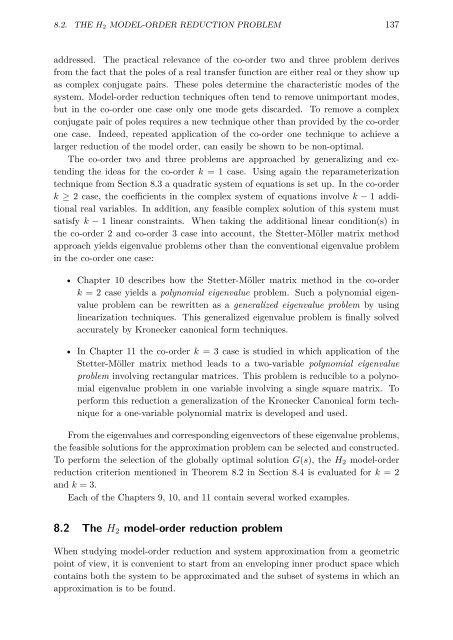link to my thesis
link to my thesis
link to my thesis
Create successful ePaper yourself
Turn your PDF publications into a flip-book with our unique Google optimized e-Paper software.
8.2. THE H 2 MODEL-ORDER REDUCTION PROBLEM 137<br />
addressed. The practical relevance of the co-order two and three problem derives<br />
from the fact that the poles of a real transfer function are either real or they show up<br />
as complex conjugate pairs. These poles determine the characteristic modes of the<br />
system. Model-order reduction techniques often tend <strong>to</strong> remove unimportant modes,<br />
but in the co-order one case only one mode gets discarded. To remove a complex<br />
conjugate pair of poles requires a new technique other than provided by the co-order<br />
one case. Indeed, repeated application of the co-order one technique <strong>to</strong> achieve a<br />
larger reduction of the model order, can easily be shown <strong>to</strong> be non-optimal.<br />
The co-order two and three problems are approached by generalizing and extending<br />
the ideas for the co-order k = 1 case. Using again the reparameterization<br />
technique from Section 8.3 a quadratic system of equations is set up. In the co-order<br />
k ≥ 2 case, the coefficients in the complex system of equations involve k − 1 additional<br />
real variables. In addition, any feasible complex solution of this system must<br />
satisfy k − 1 linear constraints. When taking the additional linear condition(s) in<br />
the co-order 2 and co-order 3 case in<strong>to</strong> account, the Stetter-Möller matrix method<br />
approach yields eigenvalue problems other than the conventional eigenvalue problem<br />
in the co-order one case:<br />
• Chapter 10 describes how the Stetter-Möller matrix method in the co-order<br />
k = 2 case yields a polynomial eigenvalue problem. Such a polynomial eigenvalue<br />
problem can be rewritten as a generalized eigenvalue problem by using<br />
linearization techniques. This generalized eigenvalue problem is finally solved<br />
accurately by Kronecker canonical form techniques.<br />
• In Chapter 11 the co-order k = 3 case is studied in which application of the<br />
Stetter-Möller matrix method leads <strong>to</strong> a two-variable polynomial eigenvalue<br />
problem involving rectangular matrices. This problem is reducible <strong>to</strong> a polynomial<br />
eigenvalue problem in one variable involving a single square matrix. To<br />
perform this reduction a generalization of the Kronecker Canonical form technique<br />
for a one-variable polynomial matrix is developed and used.<br />
From the eigenvalues and corresponding eigenvec<strong>to</strong>rs of these eigenvalue problems,<br />
the feasible solutions for the approximation problem can be selected and constructed.<br />
To perform the selection of the globally optimal solution G(s), the H 2 model-order<br />
reduction criterion mentioned in Theorem 8.2 in Section 8.4 is evaluated for k =2<br />
and k =3.<br />
Each of the Chapters 9, 10, and 11 contain several worked examples.<br />
8.2 The H 2 model-order reduction problem<br />
When studying model-order reduction and system approximation from a geometric<br />
point of view, it is convenient <strong>to</strong> start from an enveloping inner product space which<br />
contains both the system <strong>to</strong> be approximated and the subset of systems in which an<br />
approximation is <strong>to</strong> be found.

















